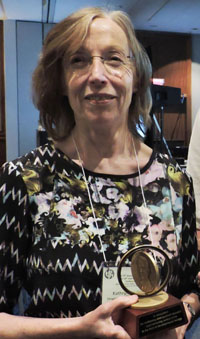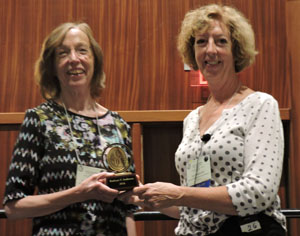Kathryn V. Anderson Awarded 2016
Conklin Medal
By Marsha E. Lucas
 The
Society for Developmental Biology awarded the 2016
Edwin G. Conklin Medal
to
Kathryn V. Anderson of the
Sloan-Kettering Institute for her extraordinary
research contributions to the field of developmental
biology and training of the next generation of
scientists. Anderson has been a leader in both the
fly and mouse genetics communities. She identified
Toll as an essential gene for establishing the dorsoventral axis in Drosophila and went on to
characterize numerous components of the Toll pathway
and its role in innate immunity. She expanded her
work into mice conducting forward genetic screens to
identify genes required for early patterning in
vertebrates. Through this work she identified novel
genes in the Hedgehog signaling pathway and
established a strong link between Hedgehog signaling
and cilia biogenesis. The
Society for Developmental Biology awarded the 2016
Edwin G. Conklin Medal
to
Kathryn V. Anderson of the
Sloan-Kettering Institute for her extraordinary
research contributions to the field of developmental
biology and training of the next generation of
scientists. Anderson has been a leader in both the
fly and mouse genetics communities. She identified
Toll as an essential gene for establishing the dorsoventral axis in Drosophila and went on to
characterize numerous components of the Toll pathway
and its role in innate immunity. She expanded her
work into mice conducting forward genetic screens to
identify genes required for early patterning in
vertebrates. Through this work she identified novel
genes in the Hedgehog signaling pathway and
established a strong link between Hedgehog signaling
and cilia biogenesis.
Anderson received her bachelor’s in biochemistry
from the University of California, Berkeley in 1973;
a master’s in neurosciences from Stanford in 1975;
and her Ph.D. in biology from the University of
California, Los Angeles in 1980. She did a postdoc
at the Max Planck Institut in Tübingen, Germany with
Christiane Nüsslein-Volhard before starting her lab
at the University of California, Berkeley in 1985.
Since 2002, she’s been a member of the
Sloan-Kettering Institute Developmental Biology
Program.
I interviewed Anderson in 2013 when she was awarded
the FASEB Excellence in Science Award. Check out
that
interview for stories behind some of her
greatest scientific discoveries and the
extraordinary women role models she’s had throughout
her career. Below is our August 2016 interview
following the 75th SDB Annual Meeting where she
received the Conklin Medal. Some questions have been
edited for brevity and clarity.
Where did you grow up?
Southern California. I [was] raised in La Jolla
right on the beach. Not in the ritzy part of La
Jolla, but in La Jolla.
How and when did you become interested in
science?
I’ve thought about this recently and think probably
my father had a lot to do with it. I think he was a
frustrated scientist. He was very supportive in
things like science fairs. And then, I had a really
terrific biology teacher in high school who made
everything seem really alive and vibrant. Before
then [I] had thought that scientists worked in
laboratories and never saw the sun. But, he made it
seem really interesting. We read The Double Helix
[by James Watson] for the class in high school
biology and it was clearly more than just people
sitting in laboratories playing with test tubes.
If you weren’t a scientist, what would you be
doing?
There are lots of things that interest me. I started
out as an English major in college because I really
loved to write. And still writing is a big part of
what I like about the job. Maybe I would have ended
up as a real writer.
Is it true that you’re still dissecting embryos
at the microscope in the lab?
I am. It’s kind of
self-indulgent I think. It’s not what I’m paid for.
But, I love it. I refuse to give it up.
Do you still have a lot of mouse lines from your
forward genetic screen that you are trying to
identify?
Actually, identifying the genes has become
ridiculously easy now with whole exome sequencing
and it’s just a very small number of embryos that
have been backcrossed for a couple of generations.
You can find the mutations of interest and it’s not
that expensive and it’s very little labor. We’ve
identified a mutation in everything that we’ve cared
about. And part of that progress in the last year on
that front is that sequencing data tends to have a
lot of noise and a postdoc we’re working with in
another lab figured out some ways of getting rid of
a lot of the noise caused by sequencing errors or
genetic background errors. And so now, it’s really
ridiculously powerful.
Describe the last time a trainee brought you some
unexpected data that got you really excited.
I’m always jumping up and down at something
[laughter]. One of the things we’re looking at right
now is whether cells in the embryo do or do not have
cilia.
Brigid Hogan actually asked a question a
while ago-- whether germ cells have cilia and
whether primordial germ cells have cilia--and I
thought, that’s an interesting question. We never
really got around to looking at it. It’s not an easy
experiment to do because the early germ cells are
just isolated cells in the midst of a bunch of other
cells. But, a new postdoc managed to make it work
and it looks like primordial germ cells don’t have
cilia even though their predecessors do. So, there’s
something interesting going on there. And
unexpected. And something that opens doors to future
experiments.
|
 |
|
Anderson receiving Conklin Medal from
SDB Past President, Lee Niswander at the
75th SDB Annual Meeting in Boston, MA. |
What is the lab doing now that it wasn’t doing five
years ago?
It’s a really exciting time in mouse biology because
you can really supplement what you do in the embryo
with experiments in stem cells. You can make stem
cell lines from mutants really, really easily. There
are a lot of things that people have worked out that
you can do in stem cells that maybe don’t mimic
development but allow you to parallel development
and do more mechanistic experiments than you could
do in the embryo easily. The other thing that
everybody is doing and that’s been harder in the
mouse is imaging at single-cell resolution in real
time. That’s really lagged behind in the mouse, but
now it’s becoming doable and that’s really great to
be able to visualize processes that you’ve been
interested in for a long time in vivo. Fly people
have done this for a long time and fish people are
way ahead of mouse people. But, there are processes
in the mouse that are different and that we have a
unique genetic handle on, that now we can look at.
Where do you see the field of developmental
biology going in the next 10-20 years?
That’s a good question. It’s hard—if it was say five
years, there are so many questions that are long
standing questions that now can be addressed with
new tools, but 20 years is harder. I mean you can
say the standard stuff about applying what we’ve
learned to human health and stuff like that, but I
think that there’s a lot more that we just don’t
even know how to articulate yet. That’s not a very
good answer...but twenty years is really hard to
prognosticate.
What is the key to a long and prolific career in
science?
Having good people to work with. I’ve really been
lucky that I’ve had both people who’ve stayed in the
lab a long time and sort of been anchors for the
lab, and then really good people coming through as
students and postdocs. I’ve been really lucky in
that regard and I know it.
What does winning the Conklin mean to you?
It’s about recognition from peers. I guess in this
case I felt that the Conklin was more about me as a
mouse person than as a fly person. I made the
transition some time ago, but I think when I made
the transition, most people thought I was crazy. I
think still when people have thought about what I’ve
accomplished they think about the Toll pathway which
is really, really cool, but that’s some time ago
now. I felt this was more like a recognition of my
more recent work, which is really exciting to me to
have my colleagues value that work.
I ended our interview ended with some light-hearted
rapid fire questions.
Mac or PC? Mac.
East coast or west coast? That’s a tough one.
I’m definitely an east coast person now.
Mice or flies? Mice.
Fall semester or Spring semester? Fall.
Coffee or tea? Tea.
Biochemistry or genetics? Genetics.
Writing grants or writing papers? Papers.
Maintaining fly stocks or maintaining mouse
lines? Well, since I don’t do the former now...
maintaining flies is more fun.
Sexing flies or sexing mice? They’re exactly
the same.
Forward genetics or reverse genetics? Forward
genetics.
Graduating students or getting new students?
Graduating students.
|